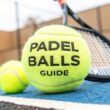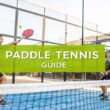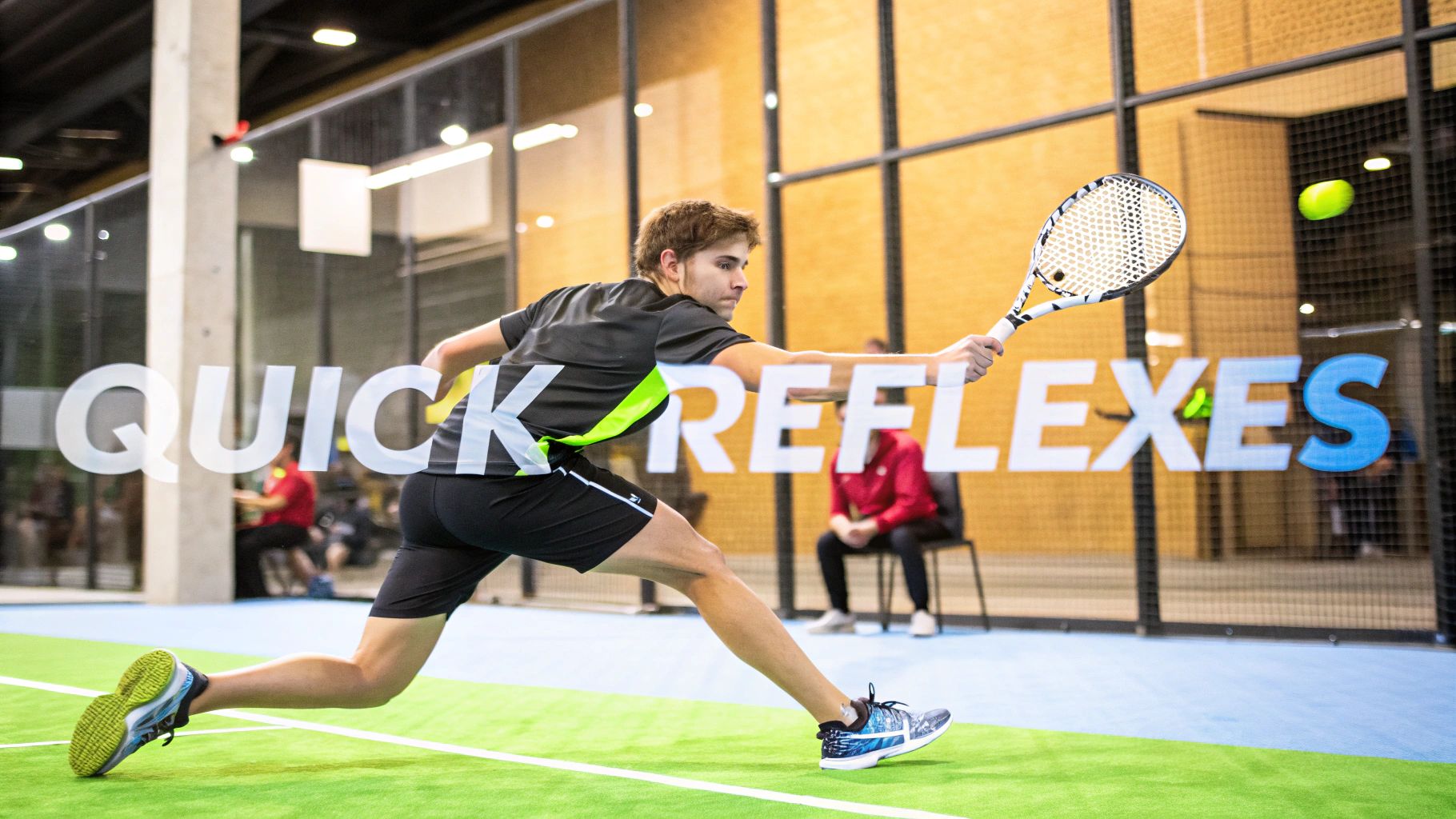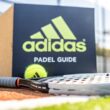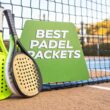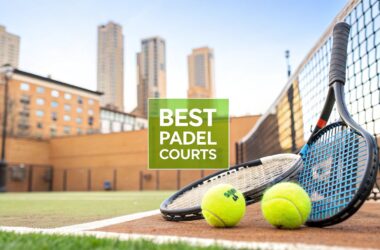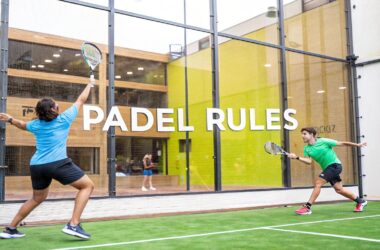In the fast-paced world of padel, the difference between winning a point and watching the ball fly past is often measured in milliseconds. While power and strategy are crucial, your ability to react instantly to unexpected shots, a wicked 'bandeja', a surprise 'vibora', or a tricky deflection off the glass, is what separates good players from great ones. This isn't an innate talent reserved for the pros; it's a trainable skill that can be systematically improved. The importance of split-second reflexes extends beyond padel, being a critical component in many athletic pursuits, including combat sports like boxing, where a fraction of a second can determine the outcome.
This guide provides a curated collection of effective reaction time exercises specifically tailored to the dynamic movements and unpredictable nature of padel. We have compiled 7 essential drills designed to sharpen your cognitive processing and physical response, giving you a decisive edge on the court. Whether you are a beginner looking to build a solid foundation or an advanced player aiming for elite performance, integrating these drills into your routine will transform your defensive scrambles and offensive attacks. Let's dive into the actionable techniques that will help you anticipate, react, and dominate your next match.
1. Agility Ladder Drills
Agility ladders are a cornerstone of Speed, Agility, and Quickness (SAQ) training, popularized by elite athletic programs in the NFL and professional soccer. The concept is simple yet powerful: a flat, ladder-like device laid on the ground through which you perform a series of intricate footwork patterns. These drills force your neuromuscular system to fire more rapidly, improving the connection between your brain and your feet.
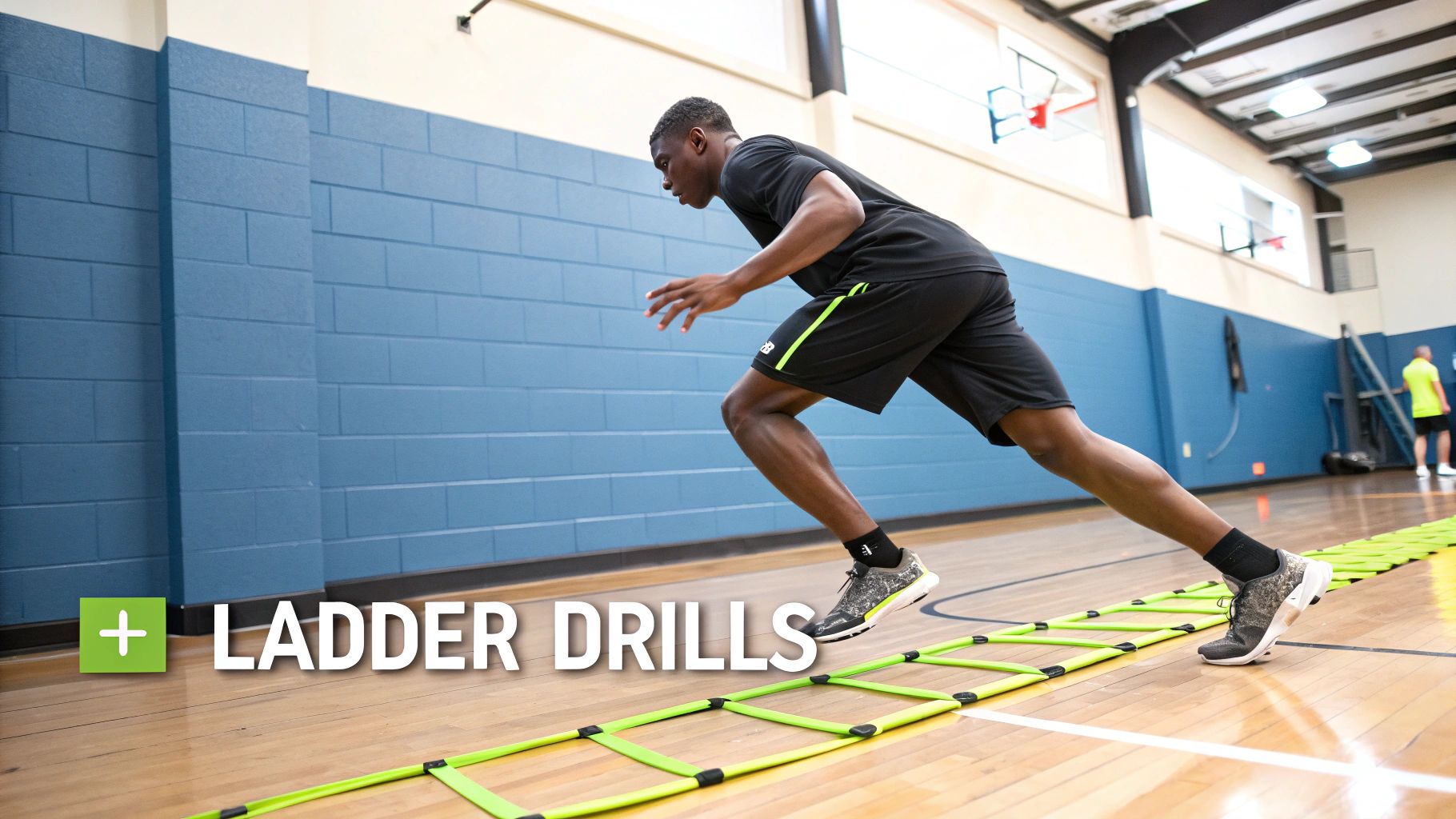
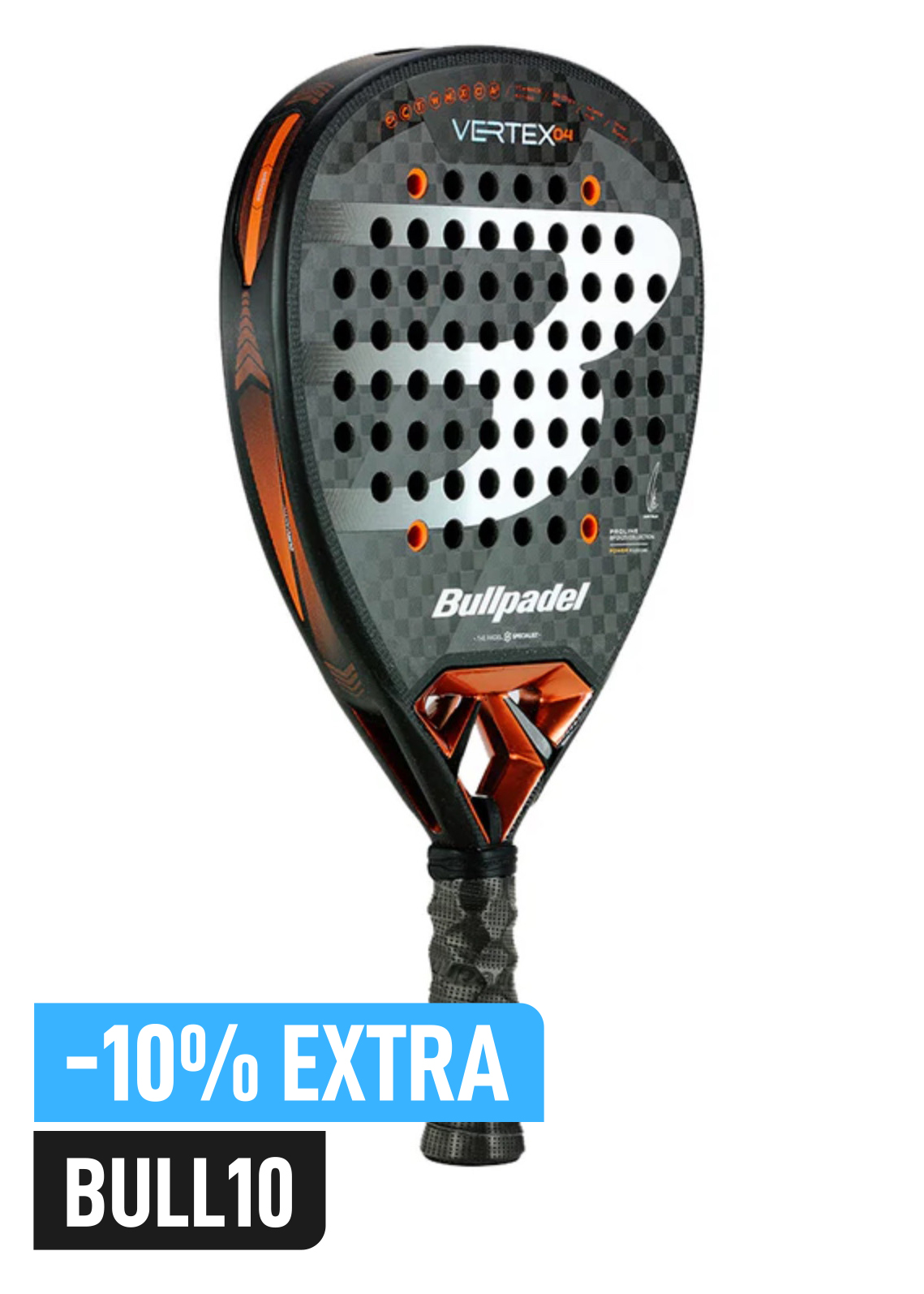
Buy the best padel gear to level up your next game!
CHECK OUT this deal from Padel Market!Get ready to take your game to the next level with the latest padel gear from Padel Market! Fast EU and Worldwide Shipping
For padel players, this translates directly to enhanced court coverage. Better footwork means you can execute the rapid, multi-directional movements required to defend lobs, counter a vibora, or quickly close the net for a volley. By conditioning your body to perform these patterns with precision, you are essentially programming it to react faster without conscious thought, a key component of high-level reaction time exercises.
How to Implement Agility Ladder Drills
To get the most out of ladder drills, focus on quality over speed initially. Your goal is to build clean, efficient movement patterns that you can later accelerate.
- Start Simple: Begin with basic drills like the "one-foot-in" or "two-feet-in" each square. Master the pattern at a walking pace before increasing your speed.
- Focus on Form: Keep your movements light and stay on the balls of your feet. Avoid looking down; instead, keep your head and eyes up as you would during a match.
- Progress Intelligently: Once you’ve mastered the basics, move to more complex patterns like the Ickey Shuffle or Lateral High-Knees. This challenges your coordination and cognitive processing.
- Integrate Padel Movements: A great way to make this drill sport-specific is to perform a short ladder sequence and then immediately sprint to a designated spot on the court to shadow-swing a volley or bandeja. This trains your body to transition from structured footwork to game-like reactions.
For a deeper look into specific footwork patterns, you can learn more about how agility ladder drills improve on-court performance.
2. Ball Drop Reaction Test
A classic exercise often used in sports science research and athletic training, the Ball Drop Reaction Test is a fundamental drill for sharpening visual processing and hand-eye coordination. A partner stands and drops a ball from shoulder height without warning, and the athlete's task is to catch it before it bounces. This simple setup directly measures and trains the time it takes for your brain to perceive the drop, send a signal to your muscles, and execute the catch.
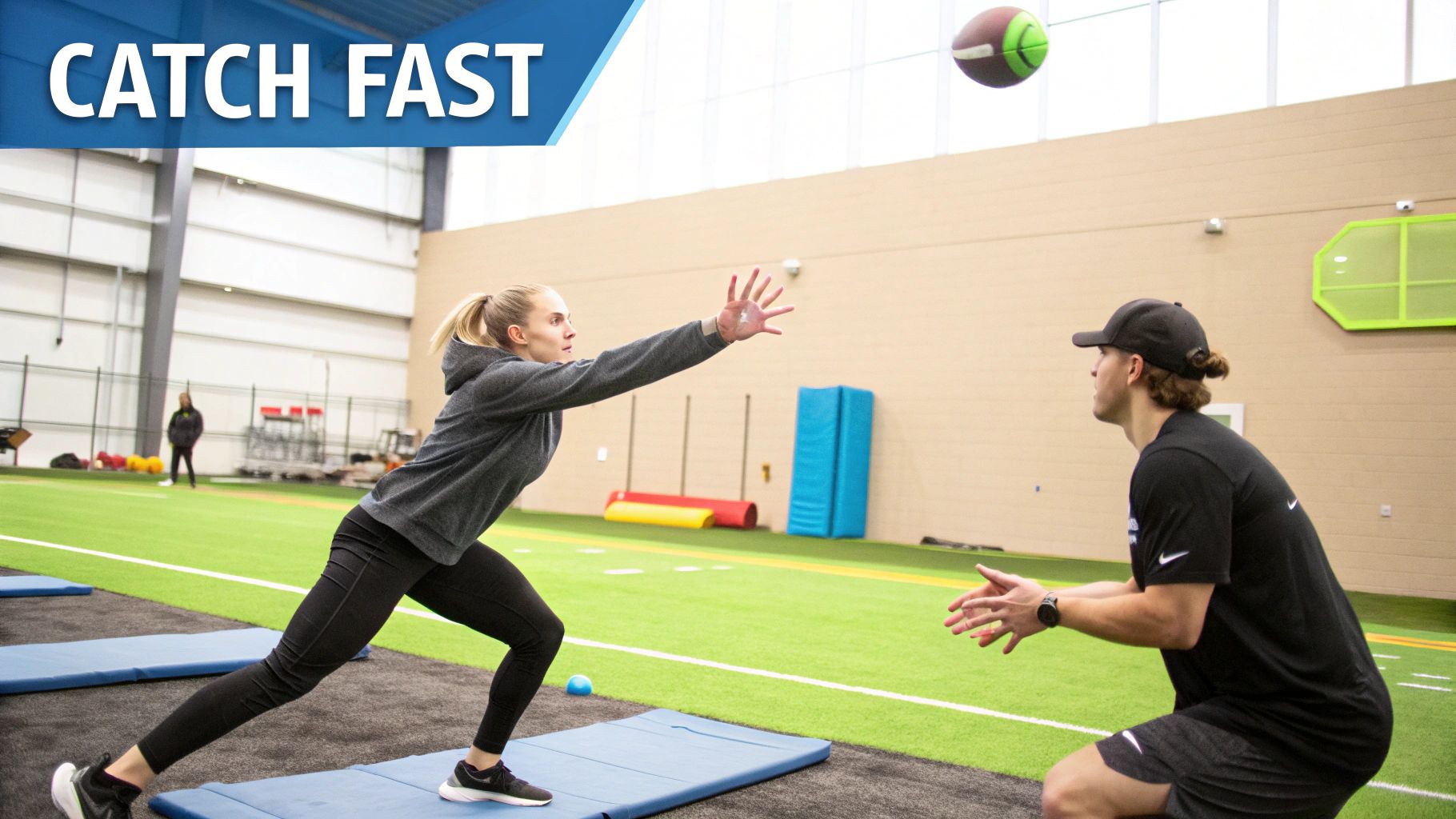
For padel players, this drill hones the exact skills needed to react to an opponent’s sudden, powerful smash or a tricky shot that deflects unexpectedly off the glass. Improving your raw reaction speed through these types of reaction time exercises means you are better equipped to handle unpredictable scenarios, getting your paddle in position faster for a successful block or counter-attack. The unpredictable nature of the drop forces a pure, instinctual response, which is crucial for high-pressure moments in a match.
How to Implement the Ball Drop Reaction Test
The key to this exercise is creating unpredictability and progressively increasing the difficulty. Consistency in practice will translate to quicker reflexes on the court.
- Vary the Drop: Have your partner vary the timing of the release. Introducing a countdown like "3, 2, 1, drop" and sometimes dropping the ball on "2" or "1" prevents you from anticipating the movement.
- Add a Cognitive Layer: Use different colored balls and have your partner call out a specific color you must catch, while ignoring the others. This forces you to make a rapid decision in addition to reacting physically.
- Practice with Both Hands: Train your dominant and non-dominant hands equally. In padel, you often have to make awkward, one-handed defensive plays, and having a responsive non-dominant hand is a significant advantage.
- Incorporate Padel Stance: Instead of just standing, get into your ready "atención" stance with your padel racket. After you catch the ball, shadow-swing a volley. This makes the drill more specific to the game, connecting the reaction directly to a padel movement.
This foundational drill is an excellent way to benchmark and improve your response time. To discover more ways to sharpen your on-court awareness, you can get better reflexes with these additional tips.
3. Light-Based Reaction Training Systems
Technology has revolutionized athletic training, and light-based reaction systems are at the forefront of this change. Used by professional athletes from Formula 1 drivers to Premier League goalkeepers, these systems utilize randomly illuminating LED pods or lights (like those from BlazePod or FitLight) that you must touch or move towards as quickly as possible. This technology directly trains your cognitive processing and motor response by creating unpredictable visual cues.
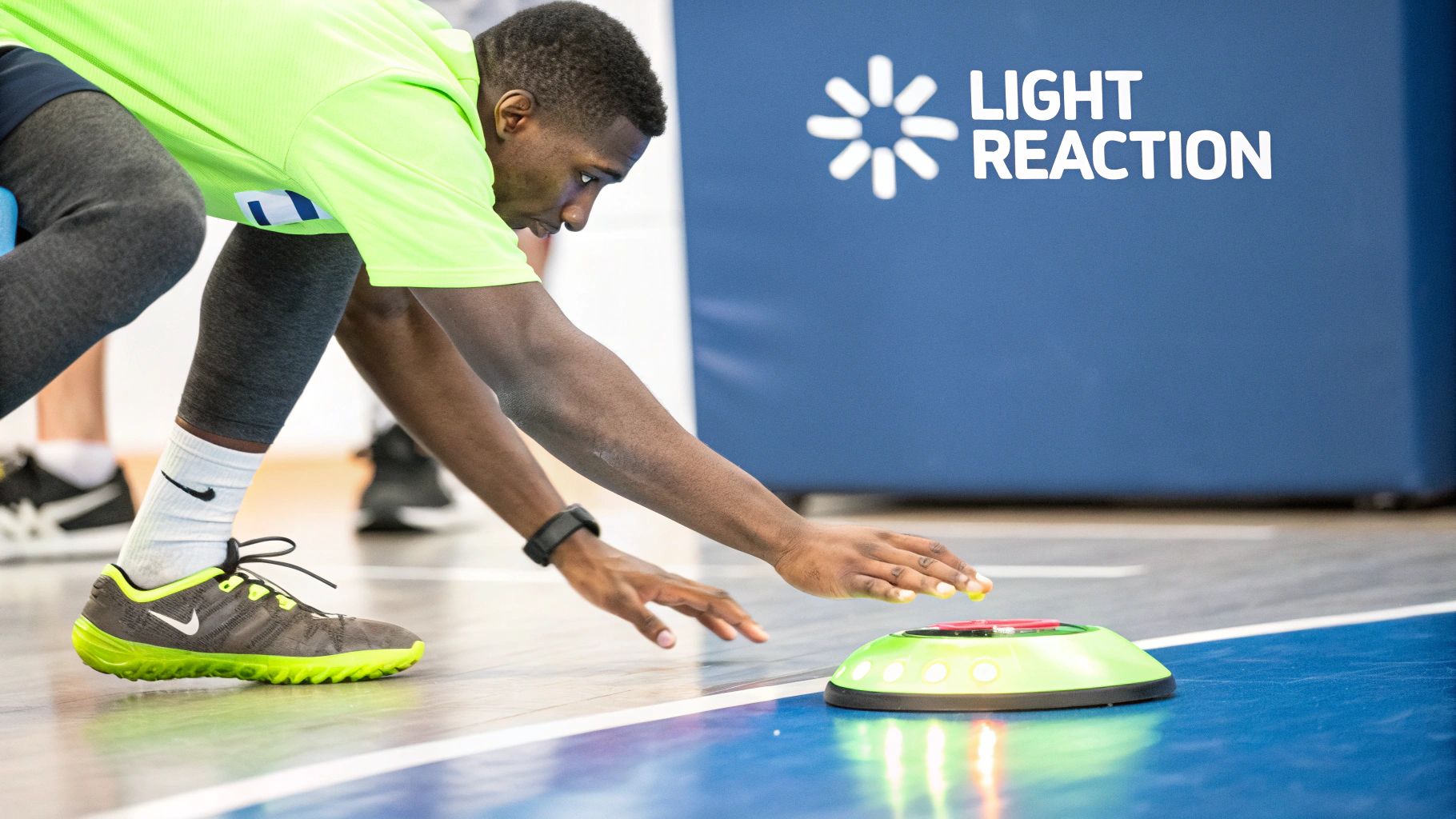
For a padel player, this type of training is invaluable. The game is a constant series of unpredictable events: a surprise drop shot, a ball hitting the side glass at an odd angle, or a fast-paced volley exchange at the net. Light-based systems simulate this randomness in a controlled environment, conditioning your brain to process a visual cue and trigger a physical response almost instantaneously. This makes them one of the most effective reaction time exercises for developing the sharp reflexes needed to dominate the court.
How to Implement Light-Based Reaction Training
The key to using these systems effectively is to bridge the gap between the drill and the on-court application. The goal is not just to tap lights quickly but to train game-relevant movements.
- Start with the Basics: Begin with a simple setup, placing a few pods in front of you. Focus on reaching and deactivating the light accurately with your hand or foot before trying to maximize your speed.
- Incorporate Padel Stances: Perform all drills from your "ready" position. This ensures you are training your reaction from the same stance you use during a point, making the skill transfer more seamless.
- Simulate Court Movement: Arrange the pods in a pattern that mimics padel movements. For example, place one pod near the net and another near the back glass, forcing you to sprint between them as they light up, simulating moving from a defensive to an offensive position.
- Add the Racket: Progress by holding your racket during drills. Instead of tapping the pod with your hand, perform a shadow swing (volley, bandeja) near the activated light. This directly connects the reaction stimulus to the specific motor pattern required in a match.
These systems offer data-driven feedback, allowing you to track your progress with millisecond precision. For a look at how these systems are used in practice, you can see BlazePod's training technology in action.
4. Mirror Reaction Drills
Mirror reaction drills are a dynamic, partner-based training method rooted in disciplines like martial arts and basketball. The premise is simple: one person acts as the "leader," executing random movements, while the other person, the "follower," must mirror those actions as quickly and precisely as possible. This exercise directly trains your reactive agility by forcing you to process visual cues and translate them into immediate physical responses.

Buy the best padel gear to level up your next game!
CHECK OUT this deal from Padel Market!Get ready to take your game to the next level with the latest padel gear from Padel Market! Fast EU and Worldwide Shipping
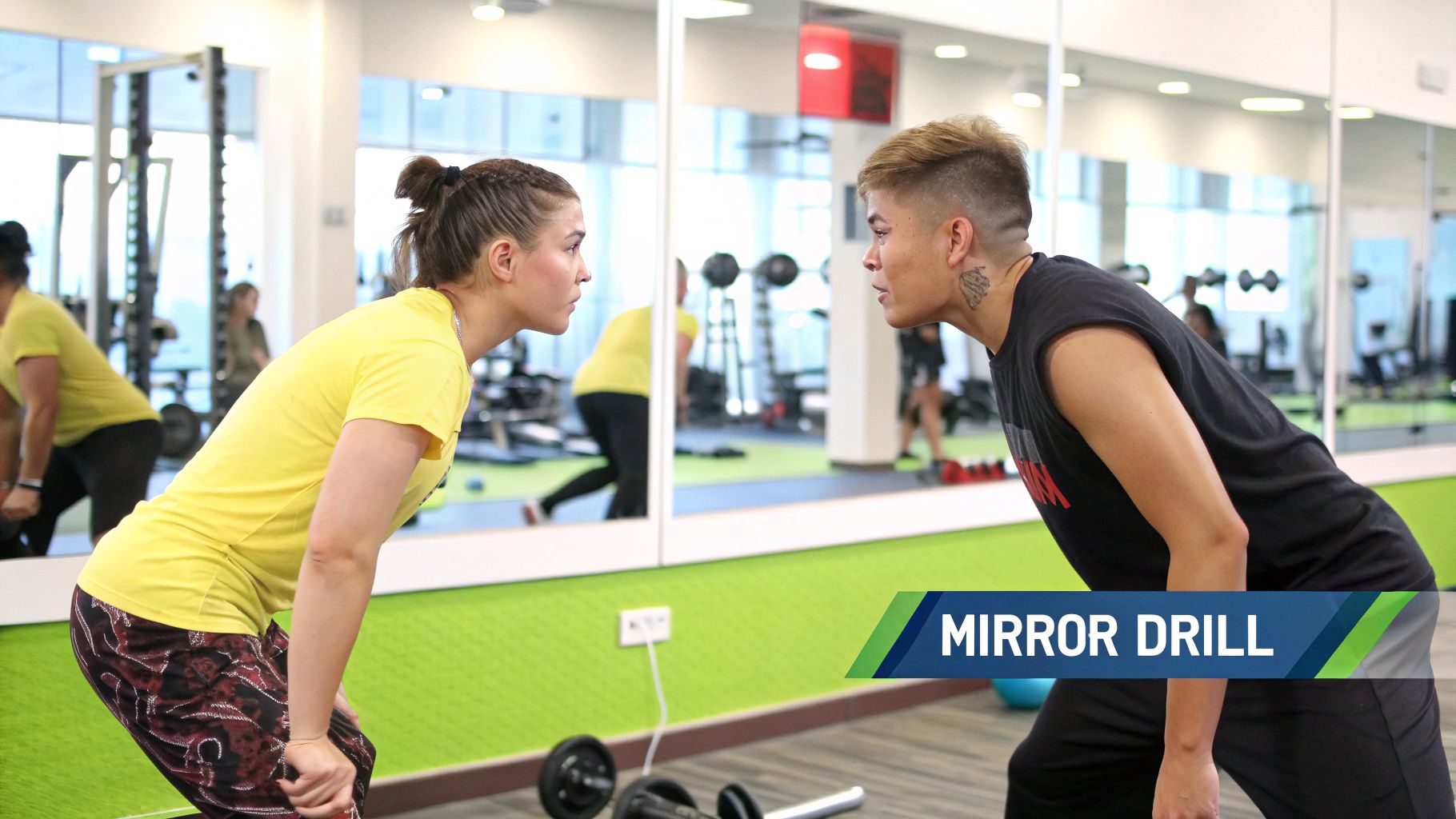
For a padel player, this is the essence of responding to an opponent. Whether anticipating a drop shot, reacting to a surprise bandeja, or adjusting your position based on your opponent’s body language, the game is a constant series of reactions. Mirror drills sharpen this specific skill set, making them one of the most effective reaction time exercises for court-based sports. They train your brain to stop guessing and start seeing, reacting to what is actually happening in front of you.
How to Implement Mirror Reaction Drills
The key to mirror drills is creating a scenario that mimics the unpredictability of a real match. Start slow to build the connection, then increase the complexity and speed.
- Define the Space: Start in a small, defined area, like the service box. The leader performs various padel-specific movements like side shuffles, split steps, and pivots, while the follower mirrors them.
- Focus on Quality First: Initially, the goal is not speed but accuracy. The follower should aim to replicate the leader's movements perfectly. As coordination improves, the leader can gradually increase the pace and complexity of the movements.
- Switch Roles Frequently: To ensure both partners benefit and stay engaged, switch the leader and follower roles every 30-60 seconds. This also provides a built-in rest period.
- Add a Padel Element: To make the drill more specific, the leader can hold a racket and shadow-swing different shots (e.g., volley, smash). The follower must not only mirror the footwork but also the corresponding swing, training the body to react as a single, coordinated unit. This directly simulates reading an opponent's shot preparation.
5. Cognitive Reaction Time Apps and Games
In the modern athletic world, training extends beyond the physical court into the digital realm. Cognitive reaction time apps and games, pioneered by platforms like Lumosity and Peak, leverage neuroscience to sharpen mental acuity. These digital tools present users with a series of engaging tasks that challenge visual processing speed, decision-making, and pattern recognition, directly targeting the neural pathways responsible for quick reactions.
For a padel player, the benefits are immense. A split-second improvement in cognitive processing can be the difference between anticipating a fast ball off the back glass and being caught out of position. These apps train your brain to identify cues, process information, and send signals to your body more efficiently. This mental conditioning is a crucial component of elite reaction time exercises, helping you read your opponents' intentions and react to unpredictable shots with greater speed and accuracy.
How to Implement Cognitive Reaction Time Apps and Games
Integrating brain training into your routine should be systematic and complementary to your on-court practice. The key is consistent, focused effort.
- Establish a Routine: Dedicate 10-15 minutes per day to these apps. Consistency is more effective than infrequent, long sessions. Treat it like a daily mental warm-up or cool-down.
- Vary the Challenges: Don't stick to just one game. Use a variety of drills that target different cognitive skills, such as attention, processing speed, and problem-solving. This ensures a well-rounded mental workout.
- Track Your Progress: Most apps provide detailed analytics. Monitor your scores over weeks and months to identify areas of improvement and plateaus, allowing you to adjust your training focus accordingly.
- Combine with Physical Drills: The ultimate goal is to transfer digital gains to the court. Immediately after a brain training session, perform a physical drill like volleying against a wall to bridge the gap between mental speed and physical execution. To further sharpen your mind and enhance cognitive speed, alongside specific reaction time training, explore how to exercise your brain.
6. Tennis Ball Wall Tosses
Tennis ball wall tosses are a classic and highly effective method for sharpening hand-eye coordination and reflex speed. Rooted in training practices from sports like baseball and tennis, this drill involves throwing a ball against a solid wall and catching the unpredictable rebound. The exercise directly trains the brain's ability to process visual information and execute a rapid physical response, which is fundamental to padel.
For padel players, this drill is invaluable for improving reactions to fast volleys, unexpected deflections off the glass, or a hard smash from an opponent. The wall acts as an unpredictable partner, forcing you to adjust your body position and hand placement in milliseconds. Mastering this skill off-court builds the neuromuscular pathways needed for instinctive, quick-fire saves and winning net play during a match, making it one of the most accessible yet powerful reaction time exercises.
How to Implement Tennis Ball Wall Tosses
The beauty of this drill lies in its simplicity and adaptability. You can start with the basics and progressively increase the difficulty to continuously challenge your reflexes.
- Start Simple: Stand a few feet from a wall and toss the ball underhand with your dominant hand, catching it with the same hand. Repeat this until it feels comfortable, then switch to your non-dominant hand to build ambidextrous coordination.
- Vary the Toss: Intentionally throw the ball with different speeds and at various angles. A harder throw results in a faster rebound, while an angled throw creates an unpredictable trajectory, mimicking game-like scenarios.
- Incorporate Movement: Instead of standing still, add lateral shuffles or small forward and backward steps between each catch. This simulates the dynamic footwork required to position yourself for a shot on the padel court.
- Increase Complexity: Progress to using two balls, either alternating throws or attempting to juggle them against the wall. You can also use different colored balls and call out a color to catch, which adds a cognitive processing layer to the drill.
These drills are a cornerstone of improving reflexes. You can learn more about how to improve hand-eye coordination for a deeper dive into these techniques.
7. Audio-Visual Simon Says Variations
This advanced take on the classic childhood game moves beyond simple commands to become a powerful cognitive-motor drill. Audio-Visual Simon Says Variations utilize a combination of sound and visual cues to trigger immediate physical responses, directly training the brain's ability to process multi-modal information and execute a corresponding action. Popularized by military training programs and cognitive rehabilitation specialists, this method builds a more robust connection between sensory input and motor output.
For a padel player, this is the essence of reacting to a fast-paced rally. You see the ball's trajectory, hear the sound of your opponent's smash, and must instantly decide whether to block, counter-attack, or defend the glass. These drills condition your brain to handle this sensory overload without hesitation, making them one of the most effective cognitive reaction time exercises for improving decision-making speed under pressure.
How to Implement Audio-Visual Simon Says Variations
The goal is to challenge your processing speed by gradually increasing the complexity of the commands. You can do this solo with an app or with a training partner calling out cues.
- Start Simple: Begin with basic audio and visual pairings. For example, a clap (audio) means step right, and a hand pointing left (visual) means step left.
- Increase Complexity: Start adding more variables. A high-pitched tone could mean jump, while a low-pitched tone means duck. A red cone shown could mean sprint forward, while a blue cone means backpedal.
- Introduce "Don't" Commands: Incorporate the classic "Simon Says" element. If the command isn't preceded by the trigger word ("Simon Says"), you must inhibit the action. This trains impulse control, which is crucial for not poaching a ball that is clearly your partner's.
- Integrate Padel Movements: Make the drill sport-specific. A partner can call out "Bandeja!" while pointing to the back-right corner, forcing you to turn and shadow-swing. Or, they could flash a yellow ball (visual) for a forehand volley and shout "Forehand!" (audio), requiring a split-step and shadow volley.
7 Reaction Time Exercises Comparison
| Training Method | Implementation Complexity 🔄 | Resource Requirements ⚡ | Expected Outcomes 📊 | Ideal Use Cases 💡 | Key Advantages ⭐ |
|---|---|---|---|---|---|
| Agility Ladder Drills | Moderate – requires coordination and practice | Low – ladder and small space needed | Improved foot speed, coordination, neuromuscular control | Sports footwork development, conditioning | Enhances multidirectional movement and rhythm |
| Ball Drop Reaction Test | Low – simple setup with partner | Very Low – a ball and partner needed | Enhanced visual reaction time and hand-eye coordination | Ball sports, driver training, fall prevention | Quantifiable and easy to perform anywhere |
| Light-Based Reaction Training Systems | High – technical setup and programming | High – specialized equipment required | Precise reaction timing, multi-directional response | Professional sports, military, fitness centers | Accurate metrics and engaging training interface |
| Mirror Reaction Drills | Moderate – partner coordination | Very Low – no equipment required | Improved reactive agility and decision-making under pressure | Martial arts, dance, defensive training | Develops full-body coordination and anticipation |
| Cognitive Reaction Time Apps and Games | Low – digital interface, easy access | Low – device required | Improved cognitive processing speed and reaction time | Convenient portable training, cognitive improvement | Gamified, detailed analytics, multi-sensory |
| Tennis Ball Wall Tosses | Low – simple solo or partner exercise | Very Low – tennis balls and wall | Enhanced hand-eye coordination and reaction speed | Racquet sports, physical therapy, youth drills | Inexpensive, adjustable difficulty, self-paced |
| Audio-Visual Simon Says Variations | Moderate – requires instruction and set up | Low to Moderate – minimal equipment or space | Enhanced cognitive-motor integration and attention | Military drills, cognitive rehab, team building | Fun, scalable, multi-modal sensory challenge |
From Drill to Domination: Making Faster Reactions Your Padel Superpower
Improving your reaction time is a game-changing investment, transforming you from a reactive player into a proactive force on the padel court. The journey from recognizing a shot to executing a response is measured in milliseconds, and mastering this split-second sequence is what separates good players from great ones. The diverse range of reaction time exercises we’ve explored provides a comprehensive toolkit to sharpen every facet of your response mechanism.
From the foundational footwork ingrained by agility ladder drills to the advanced cognitive processing demanded by light-based systems and reaction apps, each exercise targets a unique link in the reaction chain. Ball drop tests and wall tosses hone your visual tracking and hand-eye coordination, while mirror drills and audio-visual cues train your brain to process complex, unpredictable stimuli, just like you would in a high-pressure match.
Weaving Reaction Training into Your Routine
The key to unlocking your potential is not just knowing these drills but integrating them intelligently into your training. True improvement comes from consistent, deliberate practice.
- Start Small, Stay Consistent: Begin by incorporating two or three of these exercises into your warm-up routine before every session. A five-minute session with a reaction ball or a quick set of ladder drills is far more effective than one long, sporadic training block.
- Track Your Progress: Use the built-in analytics of cognitive apps to monitor your improvements. For physical drills, have a partner time your ball drop tests or simply note how much more quickly you feel you're reaching difficult shots during gameplay. Tangible data provides powerful motivation.
- Embrace Variety: Your brain and body adapt quickly. To avoid plateaus, rotate different reaction time exercises throughout your training weeks. Combine a physical drill like the wall toss with a cognitive one like a reaction app to build a more well-rounded skill set.
Beyond Speed: The True Impact on Your Game
Mastering these drills does more than just make you faster. It fundamentally changes how you perceive and interact with the game. A quicker reaction time gives you more options, allowing you to choose the optimal shot rather than just managing to return the ball. You’ll find yourself better positioned for a "bandeja," more prepared for a deceptive "vibora," and more confident in defending unpredictable shots off the glass.
Ultimately, you are training your body to react instinctively, freeing up your conscious mind to focus on strategy, positioning, and exploiting your opponent’s weaknesses. By dedicating time to these exercises, you are not just shaving milliseconds off your response time; you are building the foundation for court dominance. Your reaction time will cease to be a limitation and instead become your defining superpower.
Ready to take your padel game to the next level? Explore more expert guides, pro player insights, and in-depth gear reviews at Padel Rumors. We provide the resources you need to master every aspect of the game, from advanced techniques like these reaction time exercises to the latest court strategies. Visit Padel Rumors and continue your journey to becoming the sharpest player on the court.


